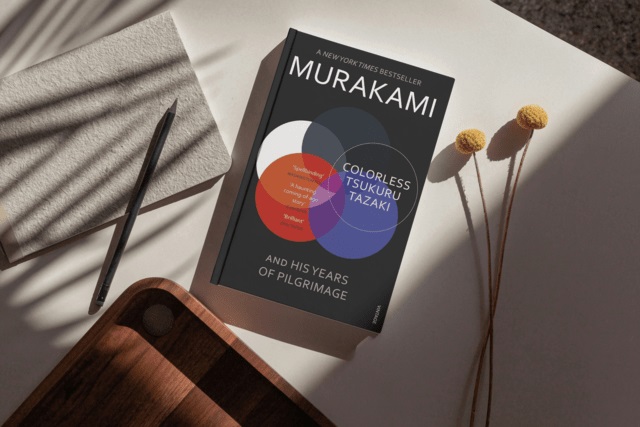Reading is often described as a journey through humanity. Books help you understand the world around you as well as faraway cultures. They show you differences between your way of life and that of someone living in a different country, speaking a different language, living in a different cultural landscape, or sometimes removed from you in a time, whether it is in the past or future. But they also show you what remains the same, the essence of humanity, our need for friendship and family, and how these shape our lives and who we become.
Author Haruki Murakami has a world-wide recognition and following for the complex setting of his simple and evocative stories that blur the lines of what we experience in reality and how we process those experiences in our minds. He is a prolific writer and we have started to share our views on some of his smaller, shorter stories here at Thinkerviews:
Recently, we found a copy of one of his latest works called Colorless Tsukuru Tazaki and His years of Pilgrimage, which explores the threads of friendship and what could have been. Here is our review of this book on behalf of Team Thinkerviews.
This Is Here In For You
Book Cover:
Now this book has been published in variety of beautiful editions, and if you can, do look up the different versions and the illustrations for each one. The book covers of these editions show a variety of themes, but all centered on mixing / merging of colors.

Colorless Tsukuru Tazaki by Haruki Murakami | Book Cover
The structure of the book, in line with other books by the author, also includes images and motifs that enhance the books, whether it is through the presence of colorless color stripes through page numbers or station maps with the chapter numbers, or the way the author’s previous works are listed.
An interesting cover page that will be attractive to the fans of the author.
Storyline
When Tsukuru Tazaki was nineteen, he lost the will to leave. He went through a long, dark tunnel contemplating death and came out the other end a different person. A grown man, but with a heart injured forevermore. Today, he works for a railroad company and builds train stations – his dream from childhood, but his inner self has stayed with that era of darkness.
His name, Tsukuru, means a builder, so that is rather apt. He meets Sara and it looks like this relationship might be the one that takes hold. And it is through his conversation with Sara that he embarks on a journey to untangle what happened all those years ago.
When he was at school, a teenager, he was part of this great group of friends, his idea of a harmonious world, comprised of two other boys and two girls. As it happened, everyone else’s name had a colour in it, and eventually they ended up with nicknames that signified colours. For example, the girls were called Shiro and Kuro – White and Black, respectively and the boys were Aka and Ao – Red and Blue respectively.
And so, Tsukuru was the odd one out. He was also the only one who left his hometown of Nagoya and went to Tokyo to study. When on one of his visits back home, he was told that none of his friends wanted to see him any more, he could think of no other response but to accept it.

Colorless Tsukuru Tazaki by Haruki Murakami | Book Cover
But that’s where his journey through darkness began – what had he done or not done? After he had recovered to some extent, he met Haida (colour Grey), and it felt like they were building a freindship, sharing experiences, swapping stories, listening to melancholic music, until one day Haida also disappeared from his life with no trace.
Tsukuru completed his study, found a job, has a flat in Tokyo, had a few relationships, but in essence he is alone. But Sara changes that. She finds the contact details for Aka, Ao and Kuro through internet and also learns that Shiro is no more. After all these years, Tsukuru visits his ‘once-upon-a-time’ friends to learn what happened? why did they cast him out, threw him overboard, in the long, dark night?
As he finds out what they thought had taken place, although believing him when he contradicts it, Tsukuru is once again at crossroads in life. Is it through action or through acceptance, that he needs to find his way forward?
Views and Reviews
The storyline above is only a brief glimpse into the world of Tsukuru Tazaki. The author builds this world with his poetic, lovingly detailed prose that navigates timelines between the present and the past. Right from the beginning, we are dealing with the question of whether the life is worth living, how sometimes the world comes to an end abruptly for one person. And how bridging that gap is so different for everyone.
This thread is further explored through the story of Haida’s father, where he meets a jazz musician from Tokyo who is on his journey towards certain death. While the story is surreal, the recommendation from it is not:
No matter how shallow and dull things might get, this life is worth living.
You need to use the thread of logic, as best as you can, to skillfully sew onto yourself everything that’s worth living for.
Sara acts as a catalyst to prompt Tsukuru in a direction to revisit his past. In many ways, she comes across as pragmatic, capable, woman of the world, but it is she who feels the emotional despair hiding deep within Tsukuru. Through their conversations, they remark candidly on the times we live in:
We live in a pretty apathetic age, yet we’re surrounded by an enormous amount of information about other people. You can easily gather that information about them, and we still hardly know anything about people.
Or the way she describes the corporate seminar business:
A quick, impromptu brainwashing course to educate your typical corporate warriors. They use a training manual instead of sacred scriptures, with promotion and high salary as their equivalent of enlightenment and paradise. A new religion for a pragmatic age.
The author shares with us musings and introspection that takes place in Tsukuru’s mind which builds the first half. His musings about his own journey, his doubts and his observations will resonate with almost every reader.
Jealousy was the most hopeless poison in the world. Jealousy was not a place he was forced into by someone else, but a jail in which the inmate entered voluntarily, locked the door, and threw away the key. And not another soul in the world knew he was locked inside.
And when he meets his friends after this long gap, their conversations bring forth the differences between their teenage selves and their adult selves. They are all more or less successful in the sense that they have jobs, have experienced love, partnership, parenthood, while have also faced the challenges which come with being an adult.
They all now look back and see what they believed at the time, was not what they believe today:
The truth sometimes reminds me of a city buried in sand. As time passes, the sand piles up even thicker, and occasionally it’s blown away and what’s below is revealed.
You can hide memories, but you can’t erase the history that produced them.

Colorless Tsukuru Tazaki by Haruki Murakami | Book Cover
The meeting that leaves the most lasting impression on the readers would be that between Tsukuru and Kuro (Eri, as she now wants to be called). Her life today is not something she could have imagined growing up. But it is only through opening up yourself to new possibilities that you could create a life. Between her and Tsukuru, there is so much ‘could-have-been’, that they both now know and can make their peace with.
One heart is linked to another not through harmony alone, but deeply through their wounds. Pain to pain, fragility to fragility. There is no silence without a cry of grief, no forgiveness without bloodshed, no acceptance without a passage through acute loss.
The author once again brings to life the pain and sorrow that goes with being human, but also the hope, the possibilities and the futures that come with being alive. He leaves the readers to imagine the ending of the love story in the book, but Tsukuru still continues to enjoy what he has always enjoyed, watching a train station functioning faultlessly.
And he now also knows that that group was special, that he and his friends were able to truly believe in a world of peace and harmony, and that is not something to forget or regret.
Not everything was lost in a flow of time.
Summary:
A beautifully executed tale of growing up, finding out why your life is worth living, and discovering love and happiness deep within the self…
ThinkerViews Rating:
Around 7.5 stars out of 10.
Quick Purchase Links:
- Buy - Colorless Tsukuru Tazaki by Haruki Murakami - Paperback - Amazon IN
- Buy - Colorless Tsukuru Tazaki by Haruki Murakami - Kindle EBook - Amazon IN
- Buy - Colorless Tsukuru Tazaki by Haruki Murakami - Audiobook - Amazon IN
- Buy - Colorless Tsukuru Tazaki by Haruki Murakami - Paperback - Amazon US
- Buy - Colorless Tsukuru Tazaki by Haruki Murakami - Audiobook - Amazon US
Over To You:
If you already have read the book do share your remarks and thoughts via comments below. Does this review help you in making your decision to buy or read the book? Do not forget to share this article with your friends over various social networks. Please follow/subscribe us on various Social networks like Twitter, Facebook, YouTube, Spotify, Amazon Prime Music, Audible, and others. And yes, you may like to subscribe to our RSS feeds to get latest updates for the site to land right in your mail box.
 ThinkerViews – Views And Reviews Personal views and reviews for books, magazines, tv serials, movies, websites, technical stuff and more.
ThinkerViews – Views And Reviews Personal views and reviews for books, magazines, tv serials, movies, websites, technical stuff and more.



